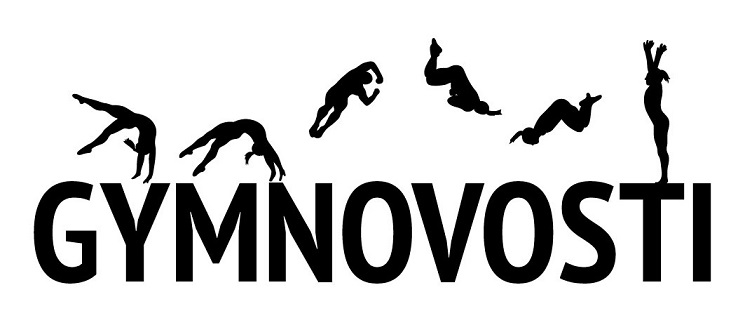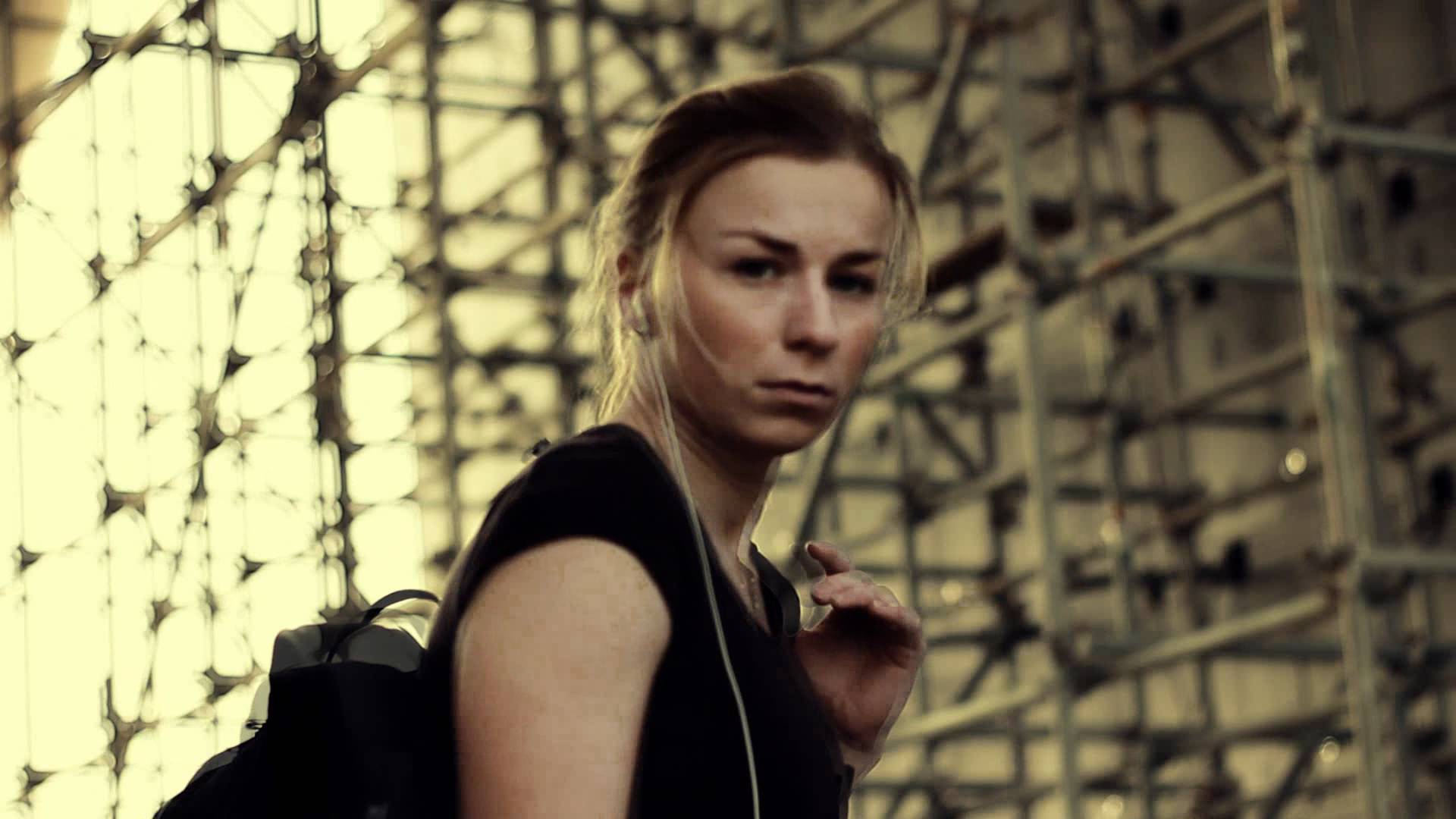Aleksandra Shevchenko didn’t enjoy a long gymnastics career having to retire after 2004 because of injuries. Her first major international competition – the 2003 Worlds – didn’t go so well and she received quite a few negative reactions with the commentator Elfi Schlegel even calling her “untalented” during the broadcast. Shevchenko disappeared from the public eye for a while, working as a coach, but then picked up parkour and she’s now competing at FIG competitions again – this time, as a parkour star.
Shevchenko gave an interview to Boris Hodorovkskiy for the Gymnastics magazine, the official magazine of the Russian Artistic Gymnastics Federation.
Q: How did you start doing artistic gymnastics?
A: It all started in Baikonur. My father served in Russian Space Forces, he was responsible for the electrical equipment. Back then it seemed like a mundane thing but now I understand: if he didn’t check it well, nothing would be launched. I was a very active child. My mom says I was always hanging from the chandelier. The officer wives were responsible for all the cultural and athletic activities in Leninsk where the spaceport employees lived. One of them organized gymnastics classes in a room under the bleachers of the local stadium. Then her husband was transferred to Moscow and the classes stopped. My mom took me to a rhythmic gymnastics class but after the very first lesson where they started stretching me I burst into tears and refused to go again. This would’ve been the end of my athletic career but then my dad was transferred to Leningrad [St Petersburg]. There I started training with Yuri Georgievich Maltsev and when he went to work abroad I started working with Margarita Konstantinovna Semenova. I remember how at the competition “Russian Jewels” I took third place on vault. The sponsors provided prizes for the medalists and we could choose which one to get. I really liked a photo album with a soft cover, I still have it. My mom scolded me then: “You should’ve taken the china set!” I don’t even remember now how old I was. Around ten years old, I guess.
Q: Surely, you remember the 2003 Russian Championships where you took third place in the all-around behind Khorkina and Pavlova much better.
A: The gap between the two strongest gymnasts and the rest was colossal then. Once I was able to get ahead of the gymnasts who were on the same level as me but I was still too far away from the team leaders.
Q: What was your first impression from Round Lake?
A: Flexibility was never my strength and there, from the start, were exercises that I just couldn’t do. I still remember how I tried to squat without raising my heels up. The warm-up hadn’t ended yet and I already realized it was all too hard for me. I was almost crying. On the national team, you had to do everything beautifully and cleanly, even during the practices. It was unusual for me.
Q: You were only 15 and Svetlana Khorkina and Elena Zamolodchikova were training alongside you. How did Olympic champions react to the newcomers?
A: Well, I wasn’t alone in that role there. Someone new came to Round Lake every month. We all had normal relationships. I even roomed with Elena for a while. But I still had more in common, due to our age, with Anya Pavlova, Masha Kryuchkova, Ziganshina sisters.
Q: After doing great at the Russian Championships, you made the national team for the 2003 Worlds in Anaheim but competed quite unsuccessfully on the floor in the team final.
A: I’d never been to international competitions before and the first one was Worlds and I was put on first on the very first event! I was doing floor while practically unconscious. I fell two times and got very upset. The whole team was trying to console me. Leonid Yakovlevich Arkayev then took me aside and said that it would get better. But many blamed the failure of the team in Anaheim on me. Like, the unsuccessful start led everything else astray.
Q: Did you have a chance to go to the 2004 Olympics in Athens?
A: I was even trusted to compete at the Olympic test event in Greece. I was on the list of the candidates for the Olympic team and went to the selection camp. Alas, my legs didn’t tolerate the training load. As gymnasts say, they got “pounded”. It wasn’t even injuries, just the accumulation of fatigue. I had to have a surgery on one ankle and to clean up the other ankle. I was in so much pain I couldn’t compete anymore. I was told: “Don’t worry, you’ll miss the European Championships, recover and come back”. Only at the end, I didn’t make it to the Olympics or even the Universiade… I quit gymnastics several times, then realized I still loved it and kept coming back.
Q: Why didn’t you become a gymnastics coach?
A: I tried. I came to a sports school, I was offered to work for the salary of 4,000 rubles. Two groups of kids, for each one I’d get paid 1,500 rubles and then another 500 bonus for the unfinished BA and another 500 for having an International Master of Sports level. The bus pass cost 1,500 rubles at the time. I started looking for a job that could sustain me and my classmate from the Olympic reserve sports school helped me to get a job at a tennis school as a conditioning coach. I worked there for almost eight years.
Q: How did you end up in parkour?
A: At some point, I started looking for a job closer to my main field and a sports club was looking for a tumbling coach. I worked as a coach for about three months and then started learning the intricacies of parkour and freerunning. I had lots of energy! And I needed to find a peaceful outlet for it. That’s how I became a tracer, that’s how the people doing parkour and freerunning are called. Although, parkour is considered an art while the competitions are only held in freerunning.
Q: Were you missing the artistic gymnastics competitions?
A: You can say so. I still like learning new things and competing against strong rivals.
Q: You were selected for the last year’s competition via an online selection by sending a video to the organizers…
A: The first time I competed was six years ago. It was more like a party were people were chosen according to who-knows-what criteria and the first sort of criteria appeared only in 2012. The top-six from the previous year get automatic berths, four guys and three girls are selected via an online competition and another five get a chance to participate in the competition by winning the qualification. Last year, 109 tracers competed in the qualification.
Q: While filming the video, how important is the job of the director, videographer, editor?
A: The selection committee is evaluating the quality of execution of a combination and not the visual effects. You have to show that the landing was onto a hard surface and not on the mats or sand. We’re filming it on our phones and edit it on the computer. Sometimes a whole day is spent on filming one combination. You keep doing the elements but make mistakes! It’s important that the person who’s filming it endures all the attempts.
Q: At the 2017 Red Bull Art of Motion, only three women competed along the men. Were the other female competitors also ex-gymnasts?
A: Pamela Forster from Austria is the same age as me, she’s also a former gymnast, she was on the national team. Sydney Olson from the U.S. is a bit younger, she also used to be a gymnast. Interestingly, there are no former elite gymnasts among the guys. Best case, someone was doing some gymnastics at a lower level.
Q: Which gymnastics experiences were useful for you in your new sport?
A: Clean execution. Many make comments, though: “You’re a gymnast, it’s easy for you to point your toes!”. Yes, it’s easy now, after 15 years of training. I easily learn the elements in which I need to move along the diagonal or push off the wall. I learn them faster than those who didn’t do sports as kids, but there’s still stuff that’s hard for me.
Q: In addition to freerunning, you tried working as a model…
A: It was just for the presentation of the volunteers’ uniforms for the Sochi Olympics, they filmed a video with tracers. We were demonstrating pretty uniforms for a whole day so that the cameramen could film us. The next day was the presentation attended by the IOC president Tomas Bach and his colleagues. They showed the video and then at the end, we jumped on the stage in the same uniform. It was spectacular.
Q: The IOC and the international federations are really interested in promoting new sports…
A: The FIG President Morinari Watanabe saw his first parkour competition in 2011 in Japan and immediately wanted to include parkour and freerunning under the FIG. I even participated in the presentation of parkour in Montpelier. Starting a new federation would take 20-30 years in order to get international recognition. Although, there’s no unity among the tracers.
Q: Do some of the athletes really not want to compete at World Championships or the Olympics?
A: It’s just that many don’t consider parkour a sport. For those who have been doing it for a long time, it’s art, philosophy, lifestyle. Before the presentation in Montpelier, many posted online: “Don’t steal our parkour! It’s not gymnastics!”. One of the most famous tracers, Pavel Petkun from Latvia, even got calls from his teammates while in Montpelier, they begged him not to compete in order not to ruin his reputation. Only after the presentation, many admitted their mistakes. It was a spectacular event! There was a representative of Cirque du Soleigh among the spectators and she was most amazed by the fact that our competition was attended not by the uptight businessman in suits and ties but by a regular crowd in t-shirts and jeans. In Montpelier, I met the FIG vice-president Nellie Kim. She will be curating the integration of parkour and freerunning into the gymnastics family.
Q: You weren’t able to go to the 2004 Olympics. Can your Olympic dream still be fulfilled?
A: Alas, freerunning was not included in the 2020 Olympics and I don’t think I’d last till 2024… Although, never say never.
Support Gymnovosti on Patreon from only $1 a month and help us bring to you even more awesome gymnastics coverage!



